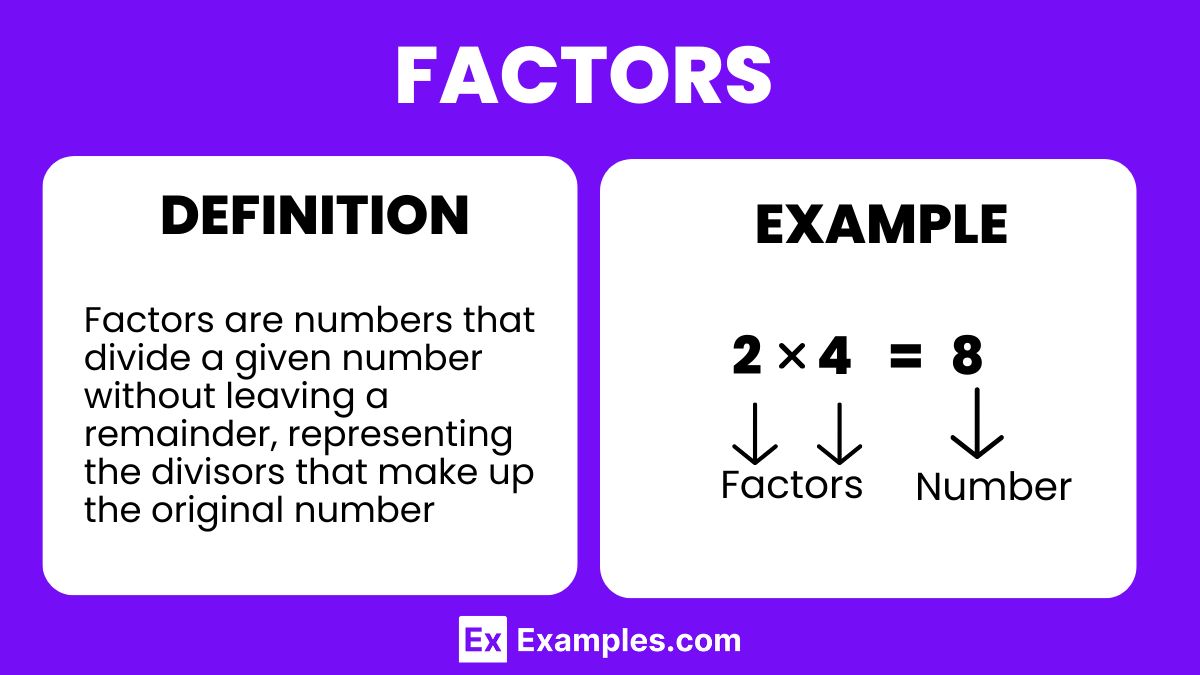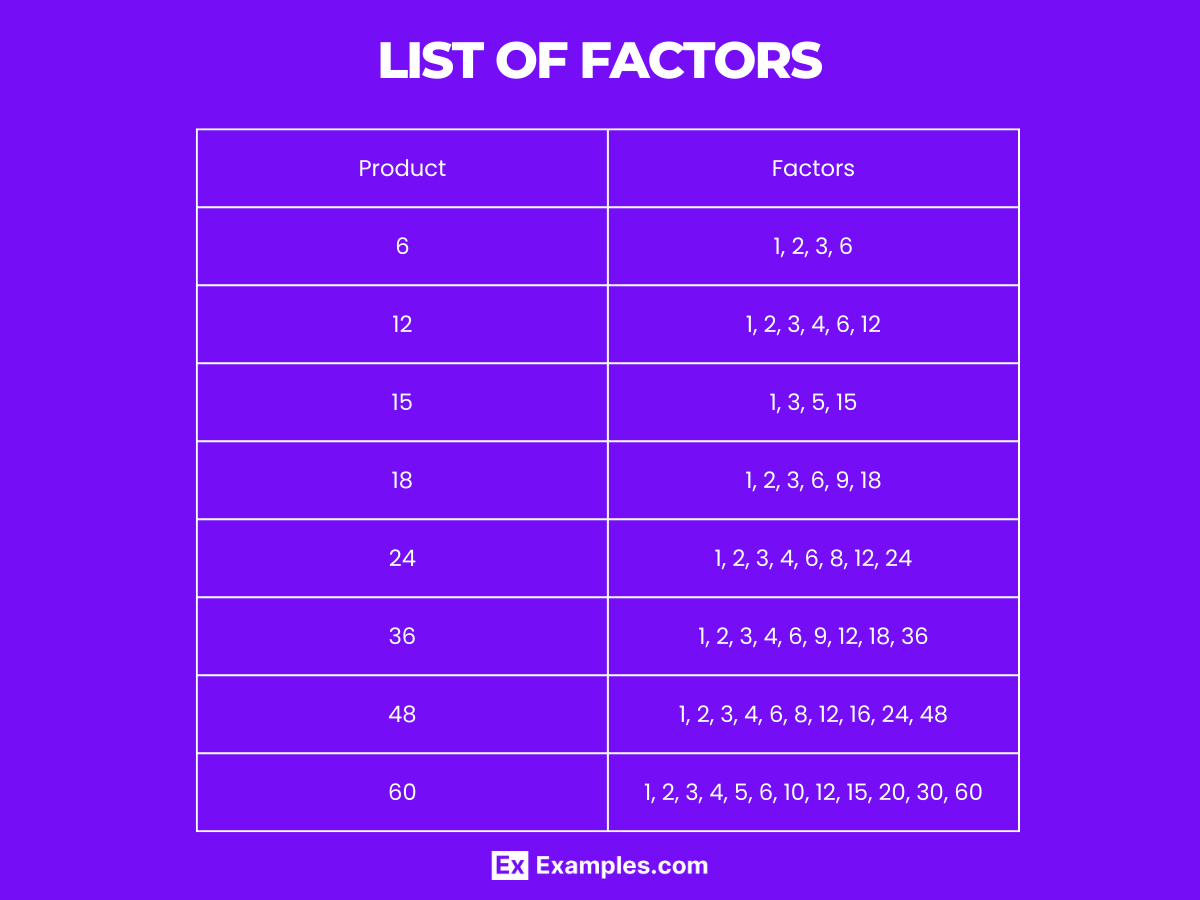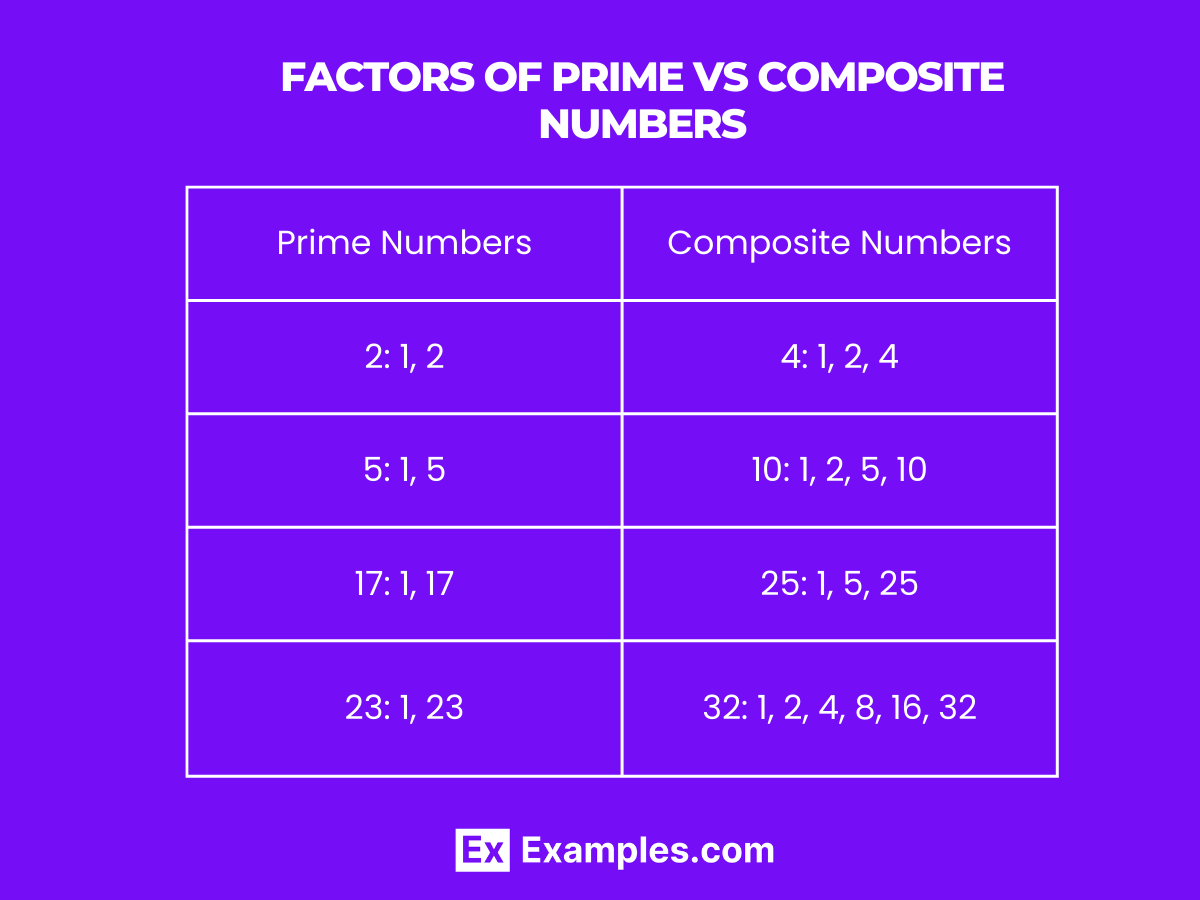Which of the following is not a factor of 36?
2
3
7
9

Factors are the building blocks of numbers, representing integers that evenly divide into another number without leaving a remainder. Understanding factors is crucial for mastering basic arithmetic, simplifying fractions, and exploring more complex mathematical concepts such as greatest common divisors and prime factorization. This guide, enriched with practical examples, demystifies the concept of factors, making it accessible and engaging for learners seeking to deepen their mathematical knowledge.
Factors are numbers that we can multiply together to get another number. Simply put, when two numbers are multiplied and the result is a certain number, those two numbers are called factors of the resulting number. For example, if we multiply 2 and 3 to get 6, then 2 and 3 are factors of 6. Factors are like building blocks of numbers, showing us which numbers can be combined to create a new number through multiplication.
A classic example to illustrate factors is the number 12. To find its factors, we look for all the pairs of numbers that, when multiplied together, equal 12. These pairs are:
So, the factors of 12 are 1, 2, 3, 4, 6, and 12. This example clearly demonstrates how factors work: they are numbers that divide into another number without leaving a remainder, fitting together like pieces of a puzzle to form the original number. Understanding factors helps in many areas of math, including simplifying fractions and finding the greatest common divisor.
When teaching the concept of factors in mathematics, it’s essential to highlight their fundamental properties. Understanding these properties not only aids students in grasping the concept but also empowers teachers to devise more effective teaching strategies. Here’s a guide to the key properties of factors:
Finding factors of a number is a fundamental concept in mathematics that is crucial for various topics such as division, multiplication, fractions, and algebra. Understanding how to determine the factors of a number helps students develop critical thinking and problem-solving skills. Here is a detailed guide on how to find factors, optimized for clarity and comprehension:
Factors are numbers you can multiply together to get another number. For example, 2 and 3 are factors of 6, because 2 × 3 = 6. A number can have multiple pairs of factors, and 1 and the number itself are always its factors.
The division method is a straightforward approach to finding all factors of a number. This method involves dividing the number by integers starting from 1 and moving up to the number itself.
| Division | Result | Conclusion |
|---|---|---|
| 24 ÷ 1 | 24 | 1 and 24 are factors of 24 |
| 24 ÷ 2 | 12 | 2 and 12 are factors of 24 |
| 24 ÷ 3 | 8 | 3 and 8 are factors of 24 |
| 24 ÷ 4 | 6 | 4 and 6 are factors of 24 |
| 24 ÷ 5 | – | 5 is not a factor of 24 |
| 24 ÷ 6 | 4 | Already listed |
From these calculations, we identify the factors of 24 as 1, 2, 3, 4, 6, 8, 12, and 24.
Step 1: Begin with the smallest factor, which is always 1. Dividing 24 by 1 (24÷1) gives 24, confirming that 1 and 24 are factors.
Step 2: Move to the next integer, 2, and divide 24 by 2 (24÷2). The quotient is 12, which means 2 and 12 are factors.
Step 3: Continue to 3, dividing 24 by 3 (24÷3). The quotient is 8, identifying 3 and 8 as factors.
Step 4: Proceed to 4, and divide 24 by 4 (24÷4). The quotient is 6, so 4 and 6 are factors.
Step 5: Test the next integer, 5, by dividing 24 by 5 (24÷5). Since it does not result in a whole number, 5 is not a factor.
Step 6: Continue this process with successive integers up to 12. Since dividing 24 by 12 (24÷12) results in 2, and both 12 and 2 have already been identified as factors, all factors of 24 have been found.
Another approach is to use multiplication, focusing on finding factor pairs that multiply to the number.
| Multiplication | Result | Conclusion |
|---|---|---|
| 1 × 24 | 24 | 1 and 24 are factors of 24 |
| 2 × 12 | 24 | 2 and 12 are factors of 24 |
| 3 × 8 | 24 | 3 and 8 are factors of 24 |
| 4 × 6 | 24 | 4 and 6 are factors of 24 |
From these calculations, we identify the factors of 24 as 1, 2, 3, 4, 6, 12, and 24.
Step 1: Start with the number 1. Multiplying 1 by 24 (1×24) gives 24, confirming that 1 and 24 are factors.
Step 2: Move to the next integer, 2. Multiply 2 by 12 (2×12), which equals 24, indicating that 2 and 12 are factors.
Step 3: Continue to 3. Multiply 3 by 8 (3×8), resulting in 24, so 3 and 8 are factors.
Step 4: Proceed to 4. Multiply 4 by 6 (4×6), which equals 24, confirming that 4 and 6 are factors.
Step 5: Check if further multiplication is necessary. After 4×6, any further multiplication would only repeat the factor pairs we’ve already found, so we conclude the process here.
By following these steps, we systematically determine all the factors of 24 using the multiplication method, ensuring a comprehensive understanding of the factorization process.
Factor pairs are a fundamental concept in mathematics, especially when it comes to understanding the factors of a number. A factor pair consists of two numbers that, when multiplied together, equal the original number. This concept is crucial for various mathematical operations and problem-solving scenarios.
Factor pairs simplify the process of finding all factors of a number by focusing on the multiplication aspect rather than division. Each pair contributes to a deeper understanding of the number’s properties and its relationships with other numbers.
To identify factor pairs of a number:
| Factor Pair | Multiplication | Result |
|---|---|---|
| 1 and 36 | 1 × 36 | 36 |
| 2 and 18 | 2 × 18 | 36 |
| 3 and 12 | 3 × 12 | 36 |
| 4 and 9 | 4 × 9 | 36 |
| 6 and 6 | 6 × 6 | 36 |
The factor pairs of 36 are (1, 36), (2, 18), (3, 12), (4, 9), and (6, 6), which also gives us the complete set of factors: 1, 2, 3, 4, 6, 9, 12, 18, and 36.

| Product | Factors |
|---|---|
| 6 | 1, 2, 3, 6 |
| 12 | 1, 2, 3, 4, 6, 12 |
| 15 | 1, 3, 5, 15 |
| 18 | 1, 2, 3, 6, 9, 18 |
| 24 | 1, 2, 3, 4, 6, 8, 12, 24 |
| 36 | 1, 2, 3, 4, 6, 9, 12, 18, 36 |
| 48 | 1, 2, 3, 4, 6, 8, 12, 16, 24, 48 |
| 60 | 1, 2, 3, 4, 5, 6, 10, 12, 15, 20, 30, 60 |
Perfect numbers hold a special place in the realm of mathematics due to their unique and intriguing properties. A perfect number is defined as a positive integer that is equal to the sum of its proper divisors, excluding the number itself. Understanding the factors of perfect numbers offers insight into their symmetrical and harmonious nature.
To fully grasp what makes a number perfect, one must first understand its factors. The factors of a number include all the integers that divide into it evenly, excluding the number itself when considering perfect numbers. The sum of these factors, when equal to the original number, categorizes it as perfect.
Finding the factors of perfect numbers involves the same process as finding factors for any integer. However, the unique aspect is that when these factors are summed, they equal the number itself. This characteristic is what defines a perfect number.
In mathematics, factors play a crucial role in various calculations and problem-solving scenarios. Understanding the different types of factors is essential for students, educators, and anyone interested in the field of mathematics. This comprehensive guide will explore the various types of factors, including prime factors, composite factors, proper factors, and more, providing insights into their definitions, characteristics, and applications.
Prime factors are the building blocks of numbers. A prime factor is a factor that is a prime number, which means it can only be divided by 1 and itself without leaving a remainder. The process of breaking down a number into its prime factors is known as prime factorization.
Unlike prime factors, composite factors are numbers that have more than two factors. These are essentially non-prime numbers (excluding 1) that can divide another number completely.
Every positive number has both positive and negative factors. The positive factors are the numbers that can divide the given number without leaving a remainder, while the negative factors are simply the negative counterparts of these positive factors.

| Prime Numbers | Composite Numbers |
|---|---|
| 2: 1, 2 | 4: 1, 2, 4 |
| 5: 1, 5 | 10: 1, 2, 5, 10 |
| 17: 1, 17 | 25: 1, 5, 25 |
| 23: 1, 23 | 32: 1, 2, 4, 8, 16, 32 |
Prime factorization is the method of breaking down a number into its constituent prime numbers, which, when multiplied together, result in the original number. This process involves dividing the number by the smallest prime numbers until the number is reduced to 1.
For instance, let’s consider the prime factorization of 18:
Thus, the prime factorization of 18 is 2×3×3
Understanding the concept of factors in mathematics is crucial for grasping the basics of number theory, which further aids in solving various mathematical problems. Factors of a number refer to whole numbers that can evenly divide the given number without leaving a remainder. In this comprehensive guide, we’ll explore a few solved problems on factors to enhance your understanding and proficiency in dealing with such mathematical challenges.
To find the factors of 24, we look for all the whole numbers that can divide 24 evenly. Starting from 1 (since 1 is a factor of every number), we test each number up to 24 to see if it divides without leaving a remainder.
The factors of 24 are 1, 2, 3, 4, 6, 8, 12, and 24.
To find the factors of 36, we will go through all whole numbers from 1 to 36 and check which ones can divide 36 without leaving a remainder.
The factors of 36 are 1, 2, 3, 4, 6, 9, 12, 18, and 36.
To identify the factors of 15, we will examine each whole number from 1 to 15 to see if it can divide 15 without a remainder.
The factors of 15 are 1, 3, 5, and 15.
When organizing a bookshelf with a collection of books from various series, prime factorization can assist in arranging them in a way that maximizes accessibility and aesthetic appeal. Suppose you have 60 books comprising several series, and you want to organize them into equal sections without mixing the series.
By applying prime factorization to the total number of books (60), we find its prime factors are 2, 2, 3, and 5 (or 22×3×522×3×5). This gives us several options for dividing the books into equal sections: 2 sections of 30, 3 sections of 20, 4 sections of 15, 5 sections of 12, 6 sections of 10, and so on.
Using these factors, you can decide how to group the books.
In Conclusion, Understanding factors in mathematics enriches our grasp of number properties, highlighting the distinctions between prime and composite numbers. Proper factors, excluding the number itself, and the balance of positive and negative factors, provide a comprehensive view of a number’s divisibility. These concepts lay the foundation for deeper mathematical exploration and problem-solving.
<br/>
Text prompt
Add Tone
How to Find Factors of a Number
Factor Pairs
Which of the following is not a factor of 36?
2
3
7
9
What are the factors of 45?
1, 2, 5, 9, 15, 45
1, 3, 5, 9, 15, 45
1, 3, 5, 7, 15, 45
1, 3, 6, 9, 15, 45
Which of the following numbers is a factor of 64?
7
8
10
11
Find all the factors of 28.
1, 2, 3, 4, 7, 14, 28
1, 2, 4, 7, 14, 28
1, 2, 5, 7, 14, 28
1, 3, 5, 7, 14, 28
What are the factors of 100?
1, 2, 4, 5, 10, 20, 25, 50, 100
1, 2, 5, 10, 25, 50, 100
1, 2, 5, 10, 20, 25, 50, 100
1, 2, 5, 10, 15, 25, 50, 100
Which number is a factor of both 30 and 45?
3
4
5
6
Which of the following is not a factor of 50?
2
5
10
12
Find all the factors of 24.
1, 2, 3, 4, 6, 8, 12, 24
1, 2, 3, 4, 5, 6, 8, 12, 24
1, 2, 3, 4, 6, 8, 10, 12, 24
1, 2, 3, 4, 5, 6, 8, 10, 12, 24
What is the greatest common factor (GCF) of 56 and 98?
7
14
28
42
Which of the following is a factor of 121?
10
11
12
13
Before you leave, take our quick quiz to enhance your learning!

